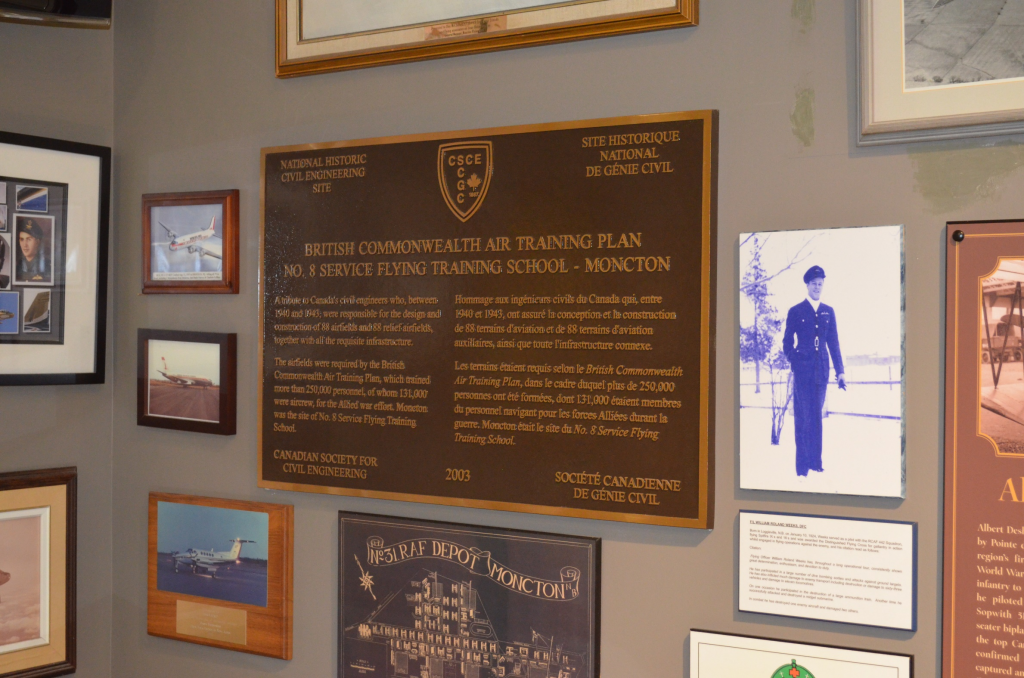
Site Location: Lat.: 46° – 6’ – 58” N; Long.: 64° – 38’ – 5” W. (GPS: 46.1161813, -64.6348025) The Greater Moncton Roméo Leblanc International Airport, 777 Aviation Avenue, Moncton. From the east: Westbound on Trans-Canada Highway 2, take NB-132S, Exit 474A, toward Dieppe/Moncton Airport. Follow NB132S for 8.1 km as it becomes Champlain St/Rue Champlain, and turn right (north) on Aviation Ave/Av de l’Aviation. Proceed 1.8 km: the airport is on the right. From the west: Eastbound on Trans-Canada Highway 2, take Exit 462 toward Caledonia Industrial Park and, after 0.4 km, turn right (south) on Harrisville Blvd/Boul Harrisville. Proceed 2.3 km and bend left onto Dieppe Blvd/Boul Dieppe. After 0.3 km, keep left (east) at the fork to stay on Dieppe and then merge onto NB-15E. After 1.2 km, take Exit `17 toward Moncton Airport and, after 0.5 km turn right (south)to merge onto Aviation Ave/Av de l’Aviation. Stay on Aviation Ave as it turns hard left (east) and, after 0.3 km, the airport is on the right.
Plaque Location: The plaque is mounted in the McClure Aviation Museum, on the second storey of the Greater Moncton Roméo Leblanc International Airport.

Description: In December 1939, Great Britain, Canada, Australia and New Zealand reached an agreement to train 1500 aircrew per month, starting in April 1940. The total estimated cost was $600 M and the estimated Canadian contribution, $350 M, was considerable given the total federal budget for 1939 was $500 M. The training rate peaked at over 3000 graduates per month. The total cost of $ 1.76 billion included a Canadian contribution of $1.59 billon.
The Moncton area was the site of five BCATP facilities. The prominent establishment was No. 8 Service Flying Training School, established in December 1940, flying Harvard and Anson aircraft. However, Moncton also accommodated No. 4 Repair Depot, No. 5 Supply Depot, No. 10 Release Center, which handled BCATP graduates awaiting convoys to England, and No. 31 Induction Center, which managed all the BCATP new recruits and assigned them to the various training facilities. Although the BCATP concluded in 1945, No. 5 Supply Depot remained operational in Moncton until its closure in 1995.

Historic Significance: The challenges for Canadian civil engineers working on the project included site selection and then the design and construction of runways, taxiways, roads, services, hangers, barracks and many other buildings to a very demanding schedule. The key to success was the development of standard airfield layouts and standard building designs using prefabricated wood components. In 1945, Winston Churchill described the BCAPT as “a spacious task imaginatively conceived and most faithfully carried out.” The initiative provided the foundation of Canada’s post-war air transportation network: of the 176 airfields constructed, 62 remain in service today including the Toronto and Vancouver International Airports.

Plaque Wording: National Historic Civil Engineering Site. CSCE. BRITISH COMMONWEALTH AIR TRAINING PLAN No. 20 ELEMENTARY FLYING TRAINING SCHOOL – OSHAWA. A tribute to Canada’s civil engineers who, between 1940 and 1943, were responsible for the design and construction of 88 airfields and 88 relief airfields, together with all the requisite infrastructure. The airfields were required by the British Commonwealth Air Training Plan, which trained more than 250,000 personnel, of whom 131,000 were aircrew, for the Allied war effort. Moncton was the site of No. 8 Service Flying Training School. Canadian Society for Civil Engineering. 2003.
SCGC. Site Historique National de Génie Civil. BRITISH COMMONWEALTH AIR TRAINING PLAN No. 8 SERVICE FLYING TRAINING SCHOOL – MONCTON. Hommage aux ingénieures civils du Canada qui, entre 1940 et 1943, ont assure la conception et la construction de 88 terrains d’aviation et de 88 terrains d’aviation auxiliaires, ansi que toute l’infrastructure connexe. Les terrains étaient requis selon le British Commonwealth Air Training Plan, dans le cadre duquel plus de 250,000 personnes ont été formées, dont 131,000 étaient membres du personnel Navigant pour les foces Alliées Durant la guerre. Monction était le site du No. 8 Service Flying Training School. 2003. Société canadienne de genie civil.
Plaque Unveiling Ceremony: The plaque was unveiled on June 6, 2003, at the Greater Moncton Airport. Sylvain Leblanc, welcomed those present and recognized the 100th anniversary of Military Engineering in Canada and the 60th anniversary of 1 Construction Engineering Unit. The dignitaries present included: Denis Beaulieu, CSCE President, who unveiled the plaque; Alistair Mackenzie, Chair of the CSCE National History Committee; Yvon Lapierre, Mayor of Dieppe; Brian Murphy, Mayor of Moncton; and Rob Robichaud, President and CEO of the Greater Moncton Airport Authority. Al Cunningham, a member of the Canadian Aviation Historical Society described the historical significance of the site.
Links to Online Documentation:
Alistair MacKenzie, “History: A Herculean Task”, Canadian Consulting Engineer, 2001.
Veterans Affairs Canada, “The British Commonwealth Air Training Plan”